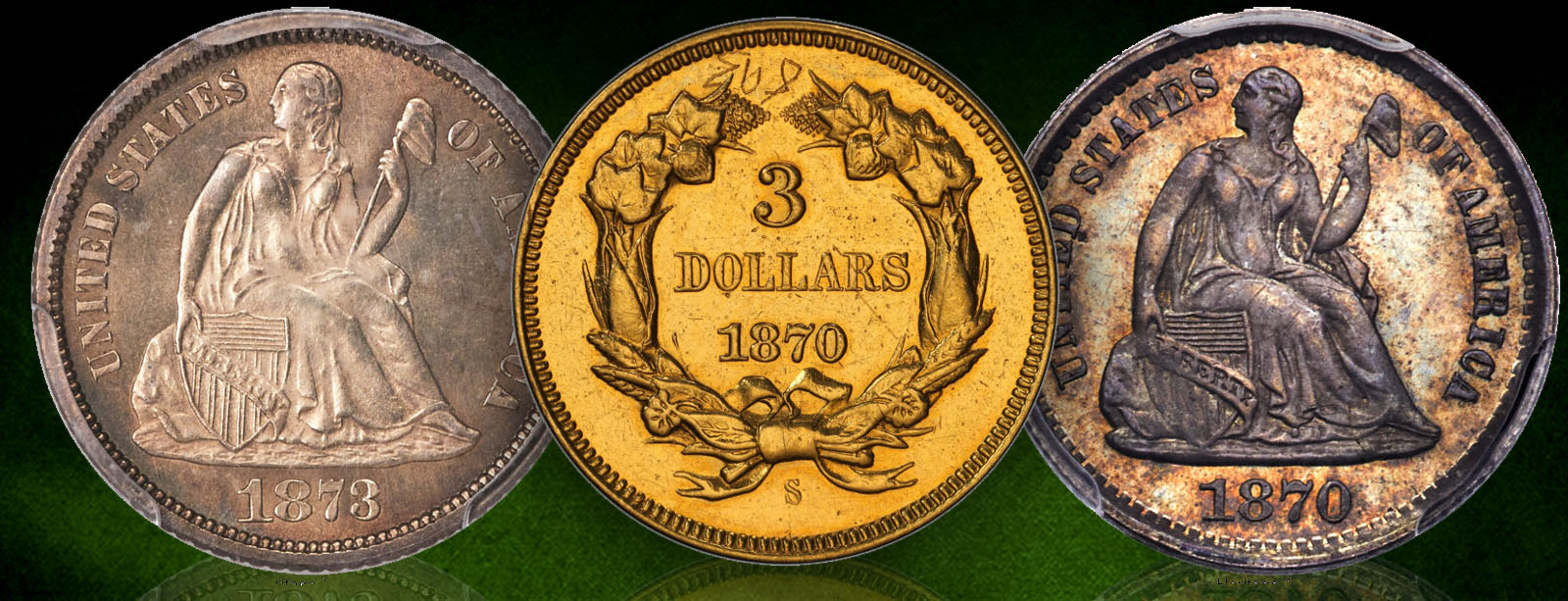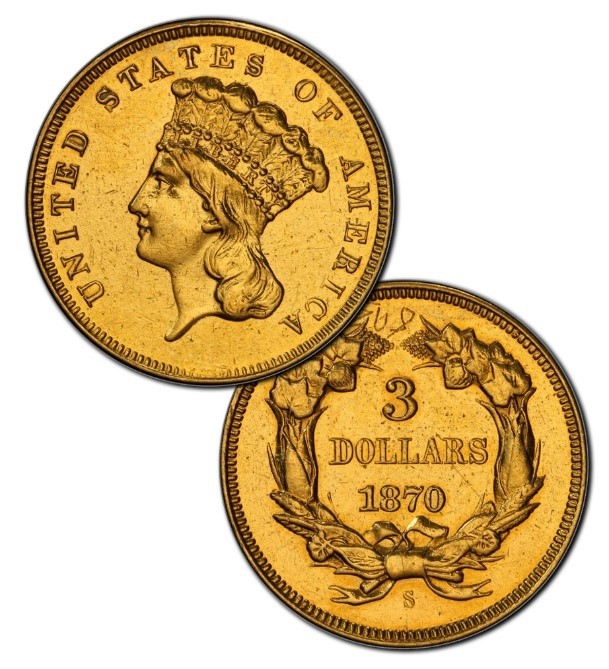IF ANOTHER 1870-S THREE DOLLAR GOLD PIECE EXISTS, IT’S BURIED UNDER THE SAN FRANCISCO MINT
By Steve Lansdale
Collectors of top U.S. coins will have three opportunities to acquire a stand-alone numismatic trophy within a single week at Heritage Auctions when a trio of unique coins are offered in The Bass Collection, Part II US Coins Signature® Auction – Orlando FUN January 5 and the FUN US Coins Signature® Auction January 11-15.
“The selection of unique coins coming to Heritage Auctions in January is extraordinary,” says Todd Imhof, Executive Vice President of Heritage Auctions. “Opportunities to acquire coins like these come along once in a lifetime – if that. To have three such chances within such a short timespan simply underscores the significance of these two auctions, as any one of these coins can forever change a collection.”
The second Bass Collection event at Heritage Auctions features an 1870-S three dollar gold, SP50, which is among the rarest and most enigmatic coins in the U.S. federal series. Reliable reports suggest that a second example, housed in a ceremonial casket, was placed under the cornerstone of the Second San Francisco Mint in 1870, but the example offered in this auction is the only known example. Assuming the reports of the second example are accurate, that coin would be forever out of reach to collectors, meaning that for all intents and purposes, the example offered in this auction is unique. Even among collectors of the world’s top coins, the 1870-S three dollar gold piece is highly coveted, fully worthy of Holy Grail status – 15 times rarer than the 1804 dollar and five times rarer than the 1913 Liberty nickel.
“This is a fascinating coin, one that the most serious of collectors have waited years for a chance to acquire,” Imhof says. “The fact that a second example might be buried under the cornerstone of the San Francisco Mint simply adds to the mystique of this coin, which is an unquestioned numismatic trophy.”
Another of the prizes in the FUN auction is an 1870-S Seated Liberty half dime, MS64 from the Bender Family Collection, the existence of which was unknown for more than a century. When the coin was revealed at the 87th Anniversary Convention of the American Numismatic Association in Houston in 1978, it was the talk of the convention. Immediately following the show, the coin appeared in major numismatic publications. The September 9, 1978, issue of Numismatic News called the mintmarked 1870 half dime “A super U.S. rarity – heretofore unknown,” and the November edition of The Gobrecht Journal had this to say about the coin’s reveal: “For the Seated collector the most significant event of the recent ANA Convention.”
“This coin made collectors sit up and take notice at the 1978 ANA because its existence was a surprise to so many,” Imhof says. “That this coin was found and proven to be genuine was a major event in the history of U.S. numismatics.”
According to Jim Simek, who worked at Chicago-based Rare Coin Company of America (RARCOA), several months prior to its display at the ANA convention, the coin was brought in by a dealer who had purchased it but did not know the exact circumstances of its provenance. Since none was listed in the Mint Director’s Report, Simek and RARCOA Vice President Dennis Forgue speculated the coin may have been a trial or transitional piece that might have been prepared when the mintmark was relocated from below the bow in 1869 to above the bow in 1871, but it “was just a guess.” They consulted with Virgil Hancock, a member of the Board of Governors and immediate past president of the ANA, as well as a founder of the ANA Certification Service, who said the coin would have to be examined under a scanning electron microscope, which revealed that the coin was genuine; details of the 1978 findings were laid out in a Certificate of Authenticity, a scan of which was included when the coin was sold at auction in 1985.
The third unique coin featured in the FUN auction is an 1873-CC No Arrows Seated dime, MS65 from the Prestwick Collection, Part II. One of the most prestigious coins ever offered through Heritage Auctions, it bears the Carson City mintmark, which appears on some of the most collected coins in U.S. numismatics. From the 12,400 1873 No Arrows dimes that were struck, Mint Director Henry F. Rice sent five examples – along with required quantities of the Seated half dollars and Seated dollars – to the Philadelphia Mint for testing in compliance with the Assay Commission statute. Shortly thereafter, the Coinage Act of 1873 required that all “old style” No Arrows dimes had to be melted. It is unclear what happened to the Assay Commission coins, but what is clear is that just one example – a Gem at that – survives today, the coin offered in this auction.
“In a way, this coin should not even exist,” Imhof says. “Coins like this one were supposed to be melted down, so the fact that this one survived is nothing short of remarkable and makes it an immediate centerpiece in whichever collection it joins after this auction.”
The provenance of this magnificent coin reads like a who’s who of American numismatics. It became part of the Eliasberg Collection in 1950, when Louis Eliasberg completed his collection when he shelled out $4,000 for it. More than half a century later, it reached seven figures when it was sold in 2004 to the Battle Born collector for $1.84 million. Eliasberg and the Battle Born collector are the only ones ever to assemble a complete collection of the 111 Carson City coins.
For the complete list of offerings in the January 5 Bass Collection, Part II US Coins Signature® Auction – Orlando FUN, visit HA.com/1355. And for the complete list of offerings in the January 11-15 FUN US Coins Signature® Auction, visit HA.com/1356. For inquiries, contact Todd Imhof at Todd@HA.com or 214.409.1313.
 STEVE LANSDALE is a staff writer at Intelligent Collector.
STEVE LANSDALE is a staff writer at Intelligent Collector.




